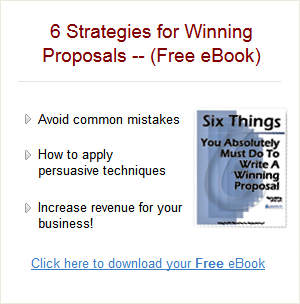Writing the Related Experience Section Proposal
When asking for proposals to provide services, clients frequently require descriptions of relevant projects. And being a conscientious proposal writer, you always respond. The problem is that too often you probably select the projects that you know are relevant and tuck them into the “Related Experience” section but don’t let the client know exactly how they are relevant.
Your Experience sections must be tailored, just like all your standard proposal sections must be tailored. They must speak directly to the client’s needs on this project. Do not expect clients to take the time to figure out how your experience is relevant. They won’t.
Why the client asks for relevant experience. When the client asks for examples of work you have done in the past, she is not simply looking for a laundry list of similar projects—she is looking for your experience on projects that closely resemble hers. Why else would she ask for it?
To make the most persuasive case that you are the best qualified to conduct this work, you should cite experience that comes as close as possible to her project. This will convey the message that you have encountered problems that you know she has, and that you have successfully addressed them. And the more specific you are in calling them out, the less time she will have to spend looking for them in your write-up.
Be specific, not general. I can’t say this too often—the client will not spend time reading your proposal to pick out the information that is relevant to her. Your job is to make that information obvious and easy to grasp.
Don’t give a general description of work you have performed in the past and hope that the client will take the time to apply that to her specific project—the chances are she won’t.
Call out specific client benefits. You need to take every chance you get to remind the client of the benefits of selecting you. This section is a perfect place to do it. Tie your past work into the proposed work, and point out how you will put what you have learned to work for your client.
This, of course, means knowing your client and her project; you can’t call out specific benefits unless you know what she wants. But you should be doing that anyway.
You cannot count on your readers connect what you have done with benefits to them. They simply won’t make the effort. You must.
Quantify your successes. If you can, give numbers. Did your approach to a certain set of tasks on a past project save the client money? Say so, and give numbers to back it up. If you don’t want to give exact dollars, give the percent of budget you saved. Did you bring the project in before schedule? How many days/months/years? Nothing makes a stronger case than a hard number.
Use graphics. Whenever possible, show pictures of past work. In color, if you can. It may be hard to show pictures of a some types of projects, but you should find a way to do it anyway. Pictures are eye-catching and they compel the reader to read the text. Also, use tables to summarize the elements of the past projects, the similarities to the proposed project, and the benefits you’ll bring.
Clients are emphasizing Relevant Experience more and more these days. This means you need to spend more time tailoring them to the job you’re going after. You can’t afford to rely on the client to see the value of your experience; you must take the time to point it out. It’ll be worth it.

